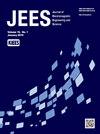C-Band GaN Dual-Feedback Low-Noise Amplifier MMIC with High-Input Power Robustness
IF 1.7
3区 工程技术
Q3 ENGINEERING, ELECTRICAL & ELECTRONIC
Journal of electromagnetic engineering and science
Pub Date : 2022-11-30
DOI:10.26866/jees.2022.6.r.137
引用次数: 1
Abstract
In this paper, using the 0.2 μm ETRI GaN HEMT process, we developed a C-band GaN dual-feedback low-noise amplifier MMIC for an RF receiver module that requires high-input power robustness. By applying a feedback microstrip line at the source of the transistor and series resistor-capacitor (RC) feedback between the gate and the drain of the transistor, we obtained stable amplifier operation and a compromised impedance trace for both input impedance matching and noise matching while suppressing performance degradation of the maximum available gain and minimum noise figure. The developed low-noise amplifier MMIC, which implements simple matching circuits by using biasing elements as matching elements, had a linear gain of more than 21.4 dB and a noise figure of less than 1.91 dB in the wide bandwidth of 4.3–7.4 GHz. Under the single-tone power test, the low-noise amplifier MMIC had an output P1dB of 14.3–20.1 dBm, and the two-tone intermodulation distortion measurement exhibited an input third-order intercept point (IIP3) of 2.2–5.6 dBm in the same frequency range as the above.具有高输入功率鲁棒性的c波段GaN双反馈低噪声放大器
在本文中,我们采用0.2 μm ETRI GaN HEMT工艺,开发了一种c波段GaN双反馈低噪声放大器MMIC,用于要求高输入功率鲁棒性的射频接收模块。通过在晶体管的源端应用反馈微带线,在晶体管的栅极和漏极之间应用串联电阻-电容(RC)反馈,我们获得了稳定的放大器工作,以及输入阻抗匹配和噪声匹配的折衷阻抗迹线,同时抑制了最大可用增益和最小噪声系数的性能下降。所研制的低噪声放大器MMIC采用偏置元件作为匹配元件,实现了简单的匹配电路,在4.3 ~ 7.4 GHz的带宽范围内,线性增益大于21.4 dB,噪声系数小于1.91 dB。在单音功率测试下,低噪声放大器MMIC的输出P1dB为14.3-20.1 dBm,双音互调失真测量在相同频率范围内的输入三阶截距点(IIP3)为2.2-5.6 dBm。
本文章由计算机程序翻译,如有差异,请以英文原文为准。
求助全文
约1分钟内获得全文
求助全文
来源期刊

Journal of electromagnetic engineering and science
ENGINEERING, ELECTRICAL & ELECTRONIC-
CiteScore
2.90
自引率
17.40%
发文量
82
审稿时长
10 weeks
期刊介绍:
The Journal of Electromagnetic Engineering and Science (JEES) is an official English-language journal of the Korean Institute of Electromagnetic and Science (KIEES). This journal was launched in 2001 and has been published quarterly since 2003. It is currently registered with the National Research Foundation of Korea and also indexed in Scopus, CrossRef and EBSCO, DOI/Crossref, Google Scholar and Web of Science Core Collection as Emerging Sources Citation Index(ESCI) Journal. The objective of JEES is to publish academic as well as industrial research results and discoveries in electromagnetic engineering and science. The particular scope of the journal includes electromagnetic field theory and its applications: High frequency components, circuits, and systems, Antennas, smart phones, and radars, Electromagnetic wave environments, Relevant industrial developments.
 求助内容:
求助内容: 应助结果提醒方式:
应助结果提醒方式:


